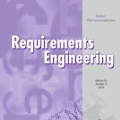For a firm in an open source software (OSS) ecosystem, the requirements engineering (RE) process is rather multifaceted. Apart from its typical RE process, there is a competing process, external to the firm and inherent to the firm's ecosystem. When trying to impose an agenda in competition with other firms, and aiming to align internal product planning with the ecosystem's RE process, firms need to consider who and how influential the other stakeholders are, and what their agendas are. The aim of the presented research is to help firms identify and analyze stakeholders in OSS ecosystems, in terms of their influence and interactions, to create awareness of their agendas, their collaborators, and how they invest their resources. To arrive at a solution artifact, we applied a design science research approach where we base artifact design on the literature and earlier work. A stakeholder influence analysis (SIA) method is proposed and demonstrated in terms of applicability and utility through a case study on the Apache Hadoop OSS ecosystem. SIA uses social network constructs to measure the stakeholders' influence and interactions and considers the special characteristics of OSS RE to help firms structure their stakeholder analysis processes in relation to an OSS ecosystem. SIA adds a strategic aspect to the stakeholder analysis process by addressing the concepts of influence and interactions, which are important to consider while acting in collaborative and meritocratic RE cultures of OSS ecosystems.
翻译:对于开放源码软件(OSS)生态系统中的公司来说,要求工程(RE)进程是相当多方面的。除了其典型的RE进程外,还有一个竞争的过程,这是公司本身和公司生态系统固有固有的过程。在试图将一个议程强加给其他公司时,为了将内部产品规划与生态系统的RE进程相协调,公司需要考虑其他利害关系方是谁和具有多大影响,以及它们的议程是什么。所介绍的研究的目的是帮助公司查明和分析开放源码软件生态系统中的利害关系方,从它们的影响和互动角度,了解它们的议程、合作者以及它们如何投资资源。为了找到解决办法,我们采用了设计科学研究方法,我们把文物设计建立在文献和早期工作的基础上。通过对Apache Hadoop OSS生态系统的案例研究,提出并展示了利害关系分析(SIA)方法在适用性和实用性方面。SIA利用社会网络构建来衡量利害关系方的影响力和互动关系,并考虑开放源码软件的特殊特征,帮助公司构建与开放源码软件生态系统有关的利益攸关方分析过程。为了达成解决方案,我们采用了一种设计科学研究方法,根据文献和早期的工作,我们采用了一种设计工艺设计方法。 利益分析方法,通过ASGSEA生态系统分析,从战略角度来看待生态系统的理念。




